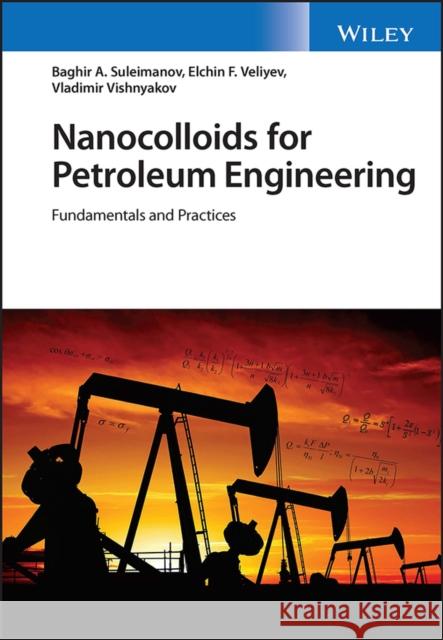Nanocolloids for Petroleum Engineering: Fundamentals and Practices » książka



Nanocolloids for Petroleum Engineering: Fundamentals and Practices
ISBN-13: 9781119889595 / Angielski / Twarda / 2022 / 312 str.
Nanocolloids for Petroleum Engineering: Fundamentals and Practices
ISBN-13: 9781119889595 / Angielski / Twarda / 2022 / 312 str.
(netto: 597,80 VAT: 5%)
Najniższa cena z 30 dni: 622,55
ok. 30 dni roboczych.
Darmowa dostawa!
Nanocolloids for Petroleum Engineering:Theoretical and Practical ApproachBaghir Suleimanov, Elchin Veliyev, Vladimir VishnyakovINTRODUCTIONPART A. Nanocolloids - an overviewChapter 1. Nanocolloids classification1.1. What is colloid?1.2. Colloids classification1.3. Colloids evaluation1.4. What is nanocolloid?Chapter 2. Nanocolloids properties2.1. Different kind of interactions in nanocolloids* Van der Waals interactions* Electrostatic interaction* Elastic-steric interaction* Hydrophobic interaction* Solvation interaction* Depletion interaction* Magnetic dipole-dipole interaction* Osmotic repulsion2.2. The stability of nanocolloids2.3. Rheology of nanocolloids* Effect of nanoparticles interaction on the colloids rheology* Effect of nanoparticles migration on the colloids rheology2.4. Surface Tension.Wettability* Wettability alteration* Surface tensionReferencesPART B. Reservoir DevelopmentChapter 3. Reservoir conditions for nanocolloids formation3.1. In-situ formation of nano-gas emulsions* Stability of the subcritical gas nuclei3.2. In-situ formation of nanoaerosoles* Stability of the subcritical liquid nucleiChapter 4. Nano-gas emulsions in oil field development4.1. Hydrodynamics of nano-gas emulsions* Flow mechanism of gasified Newtonian liquids* Annular capillary flow scheme* Slip effect* Concluding remarks* Flow of gasified Newtonian liquids in porous media at reservoir conditions* Fundamental equations* Apparent permeability* Steady-state flow4.2. Hydrodynamics of nano-gas emulsions in heavy oil reservoirs* Flow mechanism of gasified non-Newtonian liquids* Annular capillary flow scheme* Slip effect* Flow of gasified non-Newtonian liquids in porous media at reservoir conditions* Capillary flow* Flow in a homogeneous porous medium* Flow in a heterogeneous porous medium* Concluding remarks4.3. Filed validation of slippage phenomena4.3.1. Steady state radial flow* Gasified Newtonian fluid flow* Gasified non-Newtonian fluid flow4.3.2. Unsteady state flow4.3.3. Viscosity anomaly near to phase transition point* Experimental procedures* Measurement of live oil viscosity* Phase behavior of live oil and viscosity anomaly* Surfactant impact on phase behavior of live oil and viscosity anomaly* Mechanism of viscosity anomaly* Mechanism of surfactant influence on phase behavior of live oil and viscosity anomaly* Concluding remarksChapter 5. Nanoaerosoles in gas condensate field development5.1. Study of the gas condensate flow in porous medium5.2. Mechanism of the gas condensate mixture flow* Rheology mechanism of the gas condensate mixture during steady-state flowa) Annular flow scheme in a porous medium capillaryb) Slippage effect* Mechanism of porous medium wettability influence on the steady-state flow of the gas condensate* Mechanism of pressure build-up at the unsteady-state flow of the gas condensate* Concluding remarksReferencesPART C. Production OperationsChapter 6. An overview of nanocolloids application in production operationsChapter 7. Nanosol for well completion* The influence of the specific surface area and distribution of particles on the cement stone strength* The influence of nano-SiO2 and nano-TIO2 on the cement stone strength* Regression equation* Concluding remarksChapter 8. Nano-gas emulsion for sand control* Fluidization by gasified fluids* Carbon dioxide gasified water as fluidizing agent* Natural gas or air gasified water as fluidizing agent* Chemical additives impact on fluidization process* Water-air mixtures with surfactant additives as fluidizing agent* Fluidization by polymer compositions* Mechanism of observed phenomenaChapter 9. Vibrowave stimulation impact on nano-gas emulsion flow* Exact solution* Approximate solution* Concluding remarksReferencesPART D. Enhanced Oil RecoveryChapter 10. An overview of nanocolloids applications for EOR* Core flooding experiments focused on dispersion phase properties* Core flooding experiments focused on dispersion medium propertiesChapter 11. Surfactant based nanofluid* Nanoparticle influence on surface tension in surfactant solution* Nanoparticles influence on surfactant adsorption process* Nanoparticles influence on oil wettability* Nanoparticles influence on optical spectroscopy results* Nanoparticles influence on rheological properties of the nano-suspension* Nanoparticles influence on the processes of Newtonian oil displacement in homogeneous and heterogeneous porous medium were tested* Concluding remarksChapter 12. Nanofluids for Deep Fluid Diversion12.1. Preformed particle nanogels* Nanogel strength evaluation* Determination of inflection points* Kinetic mechanism of gelation* Core flooding experiments* Concluding remarks12.2. Colloidal dispersion nanogels* Rheology* Aging effect* Interfacial tension* Zeta potential* Particle size distribution* Resistance factor / Residual resistance factor* Concluding remarksChapter 13. Nano-gas emulsions as displacement agent* Oil displacement by Newtonian gasified fluid* Oil displacement by non-Newtonian gasified fluid* Mechanism of observed phenomena* Field applicationReferencesPART E. Novel Perspective NanocolloidsChapter 14. Metal string complex micro&nano fluids14.1. What is metal string complexes?14.2. Thermophysical properties of microfluids with Ni3(mu3-ppza)4Cl2 metal string complex* Microparticles of the MSC Ni3(µ3-ppza)4Cl2* Ni3-microfluid* Fluids stability* Thermal conductivity* Rheology* Surface tension* Freezing points* Concluding remarks14.3. Thermophysical properties of microfluids with Ni5(mu5-pppmda)4Cl2 metal string complex* Microparticles of the metal string complex [Ni5(µ5-pppmda)4Cl2]* Micro and nanofluids preperation* Fluids stability* Thermal conductivity* Rheology* Surface tension* Freezing points* Concluding remarksReferencesAPPENDICES
Baghir A. Suleimanov is Deputy Director of the SOCAR "OilGasScientificResearchProject" Institute, Doctor of Technical Sciences and a Corresponding Member of Azerbaijan National Academy of Sciences.Elchin F. Veliyev is Deputy Manager of Laboratory of Analytical Research at the SOCAR "OilGasScientificResearchProject" Institute.Vladimir Vishnyakov is Director of Centre for Engineering Materials at the University of Huddersfield, PhD and a Fellow of Institute of Physics, UK.
1997-2026 DolnySlask.com Agencja Internetowa
KrainaKsiazek.PL - Księgarnia Internetowa









